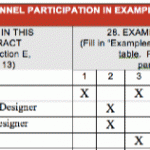
Like many firms in the A/E/C industry, the firm I work at is experiencing an uptick in business. We’ve got a lot of work and we’re hiring (If you know any schedulers or claims analysts looking, please…please send me an email).
But there is one thing we’re experiencing that I never have before. For the proposals we’ve submitted in 2014, our “hit rate” is 100%. Yes, we’ve won every contract that we’ve submitted a proposal on.
But is that a good thing or a bad thing? That’s what I want to explore with you today.
The Proposal Hit Rate
Especially when I do webinars, people always try to ask me what my “proposal hit rate” is. My answer is always this:
“It doesn’t matter.”
People always email me and ask what the industry average proposal hit rate is. My answer is always:
“Even if there was such a metric, it wouldn’t be a good measuring stick for your firm.
This idea of proposal win rate as measurement of success has been drilled into our head. I just don’t buy it. In fact, I’ve gone on record saying that it’s a flawed metric. Let’s just look at four scenarios to illustrate that point.
Let’s say there is a city with two architecture firms. Firm A has a win rate of 30% and Firm B has a win rate of 70%. Who is more successful? Firm B…right?!?!
But let’s look at it in more detail.
Firm A
- Proposals Submitted: 20
- Proposals Won: 6
- Proposal Hit Rate: 30%
- Proposal Revenue Submitted on: $10M
- Proposal Revenue Won: $7M
Firm B
- Proposals Submitted: 20
- Proposals Won: 14
- Proposal Hit Rate: 70%
- Proposal Revenue Submitted on: $10M
- Proposal Revenue Won: $3M
Now that you see it in more detail, what firm has been more successful? Clearly, it’s Firm A…not Firm B as we originally thought.
Now, there is an obvious fix to this, right? Don’t measure by number of proposals (which, by the way, everyone does)…measure by revenue submitted on. Ok, so using that approach, let’s look at another scenario.
Firm A
- Proposals Submitted: 20
- Proposals Won: 6
- Proposal Hit Rate (By % of Revenue): 70%
- Revenue Submitted on: $10M
- Proposal Revenue Won: $7M
- Proposal Revenue Won Last Year: $70M
Firm B
- Proposals Submitted: 20
- Proposals Won: 14
- Proposal Hit Rate (By % of Revenue): 30%
- Revenue Submitted on: $10M
- Proposal Revenue Won: $3M
- Proposal Revenue Won Last Year: $2M
Now which firm’s proposal efforts are more successful this year? Well, it’s safe to say you’d rather be working for Firm B than Firm A this year…wouldn’t you? But let’s consider even more detail.
Firm A
- Proposals Submitted: 20
- Proposals Won: 6
- Proposal Hit Rate (By % of Revenue): 70%
- Revenue Submitted on: $10M
- Proposal Revenue Won: $7M
- Proposal Revenue Won Last Year: $70M
- Sole Source and Add On Revenue Last Year: $2M
- Sole Source and Add On Revenue This Year: $68M
- Total Revenue Last Year: $72M
- Total Revenue This Year: $75M
Firm B
- Proposals Submitted: 20
- Proposals Won: 14
- Proposal Hit Rate (By % of Revenue): 30%
- Revenue Submitted on: $10M
- Proposal Revenue Won: $3M
- Proposal Revenue Won Last Year: $2M
- Sole Source and Add On Revenue Last Year: $6M
- Sole Source and Add On Revenue This Year: $1M
- Total Revenue Last Year: $8M
- Total Revenue This Year: $4M
Now which firm looks more successful? Firm A, right!?!?!
Now you might say, “Well, Firm A could have won a lot more work from proposals since it won $70M last year.” But consider this. We don’t know anything about the potential proposal opportunities out there for Firm A. There may have been $80M last year and $10M this year. Plus, if they won $50M more in work, that could easily put this firm out of business.
Let’s muddy the waters even more by looking at even more data.
Firm A
- Proposals Submitted: 20
- Proposals Won: 6
- Proposal Hit Rate (By % of Revenue): 70%
- Revenue Submitted on: $10M
- Proposal Revenue Won: $7M
- Proposal Revenue Won Last Year: $70M
- Sole Source and Add On Revenue Last Year: $2M
- Sole Source and Add On Revenue This Year: $68M
- Total Revenue Last Year: $72M
- Total Revenue This Year: $75M
- Proposal Costs: $1M
Firm B
- Proposals Submitted: 20
- Proposals Won: 14
- Proposal Hit Rate (By % of Revenue): 30%
- Revenue Submitted on: $10M
- Proposal Revenue Won: $3M
- Proposal Revenue Won Last Year: $2M
- Sole Source and Add On Revenue Last Year: $6M
- Sole Source and Add On Revenue This Year: $1M
- Total Revenue Last Year: $8M
- Total Revenue This Year: $4M
- Proposal Costs: $60K
Now we see that Firm A spent 14.9% of the proposal revenue won on those pursuits. Let’s not consider how the firm does its accounting (that can get messy). But let’s say that, without absorbing the firm’s proposal costs, they make 12% profit on each job. If you spent 14.9% getting the job, there is no way you can make a profit. That’s a big problem that Firm A needs to consider.
While Firm B only spent 2% of those revenues on proposal costs and they won 30% more with those efforts than last year, they are still down 50% from last year. The big question there is could they/should they have proposed on more?
The point I’m trying to make is this. To simply look to a proposal win rate as a measurement of success is foolish. Yes, even some of my closest friends will be offended by that statement. But I’ve just proven it to you.
But What About A 100% Hit Rate?
As much as I’d like to pat myself on the back, simply looking at that 100% proposal hit rate doesn’t give you any way to measure the effectiveness of our overall proposal efforts.
There is no reason to believe that the quality of our proposals has drastically improved this year or that there was less competition.
As Ford Harding once said to me, “If you win every proposal, that just means one thing…you’re not proposing on enough.” That’s our likely scenario. But were there proposal opportunities that we missed? That’s certainly the question that discovering our 100% proposal hit rate created in my head.
But unfortunately, you don’t know what you don’t know.
What Are Proposal Hit Rates Good For?
I’m not saying proposal hit rates are completely devoid of merit. Yes, they can be indicators. But as a measurement of proposal success they, well, suck.
What are your thoughts on proposal hit rates? Am I talking cRaZy? Or did I hit the nail on the head? Share your opinion by posting a comment.





Hi Matt – Great article. Before I started consulting, I led a team of proposal staff that submitted 150 SOQs and Proposals per year for a large heavy civil construction firm. We felt that ‘Hit Rates,” as defined as ‘projects won’ was a false metric. Even if the submittals were excellent and received a high score, all too often the final price, interview score, company backlog in the area, etc., were factors that affected the owner’s decision.
Instead, we measured the success of SOQ’s by our shortlist rate (98%) and our technical proposals by 1st or 2nd place scores (100%) usually in a field of four to five teams on $$50M+ contracts. We felt this was a more accurate metric for reflecting the value of our proposal processes and practices.
For example, if we scored 1st or 2nd on a design-build or P3 submittal but lost the project to a lower-scoring but much cheaper price, we were able to pinpoint where the deficiency originated.
I’m wondering, in your metric model, if the proposal efforts are unfairly sharing the responsibility for the deficiencies in the other disciplines? It seems to me the most accurate manner to measure proposal effectiveness is to isolate from project wins.
Cheers,
That’s an interesting approach. But I feel it has a similar weakness. Many firms would have a high shortlist percentage. Sometimes there is no shortlist. Sometimes there are two rounds of shortlists. And while I do like the idea of looking at your technical approach success, it is ultimately part of your proposal.
In this article, I wasn’t proposing a solution or better method. I was just punching some holes into a generally accepted practice.
You’re spot on, Matt. As I have said time and again: too many great proposals lose and terrible proposals win to make me care about hit rate as an achievement or even an indicator. There are simply too many external factors that affect the “hit.”
There are many factors that affect the “hit.” But while it’s not a good metric, I still think it can be an indicator.
Heck, I’ve submitted terrible proposals that won and great proposals that somehow lost. But ultimately my perception doesn’t matter. Only the perception of the decision makers or politician at the top matters.
Slinging proposals is an interesting profession. It’s the rare occasion where the playing field is truly level.
Agree with all your points. Its not an adequate metric. We typically use Value of Submitted vs. Value of Awards. plus a further big picture analysis.
I think what a 100% Hit Rate says about your firm is that you’ve got a solid Go/No Go process. You’ve been focusing on opportunities you can win. What does it mean for years to come? Well it probably does mean that you can start bidding on more opportunities.
Thanks for the comment!
Matt, I agree you are correct. BUT when proposal pros say the metric doesn’t mean everything, so they don’t track anything, that’s a problem. As you’ve shown the metric does not tell a complete story. But without tracking your hit rate, you have no idea (nor way to prove) that you make any difference at all to the firm’s success. Track your hit rate, and capture data on shortlisting and other things you are trying to improve, or suffer the assumption by your firm that you are merely a pretty face on overhead.
I agree that you have to track something. And certainly I’ve said hit rates can serve as a good indicator.
But when people want to know my hit rate, they are looking for something to compare themselves to. I don’t think it’s wise to use my hit rate to measure your success. I think you have to measure against yourself.
I do believe there is a better metric out there. But nobody has devised it yet.
I always heard about them and I think you can make some up. Thanks for this article post. It clears up a lot of confusing concerning numbers/data and conclusions.
No problem! 🙂
Good perspective! To me, hit rates are very much an indicator. Overall hit rates don’t get you much, but when you start to look at them by client, magnitude, service area…you name it, trends start to appear – good or bad. These indicators prompt analysis on why those trends are happening, and give a data point to triangulate with other data/intel to refine your approach. Are hit rates a good measurement of success? Well, if your firm properly uses a go/no-go process to target profitable work of the right magnitude that aligns with your firm’s strategic plan and you’re well-positioned for, then I’d say a high (or 100%) win rate is an indicator you’re on the right track.
Very interesting. Stumbled across the article via an SEO search. We’re not an engineering or design/build firm—we’re a small public-affairs firm that manages the public-involvement process (primarily P3s). Our basic bid-win rate is about 28 percent. This is our first year of really entering the bid process in an intensively focused manner as part of a strategic approach to business development. Most of our work comes from sole-source projects based on the decision-maker’s past experience with one of our staff members.We have seen all manner of bid process and, to be frank, shenanigans — from former-legislators-turned-consultants skirting the field to convince our governor’s staff to ensure proposals are written specifically to match the unique qualifications of these former “colleagues,” to state agency staff leading ad-hoc board members in how to score (biasing the process). Ourselves specifically, we’ve even had one prominent federal agency ask us to submitt a detailed proposal for a sole-source project–only to have the agency take that non-work-for-hire detailed plan and use it verbatim to launch a full-bid process to our competitors, later to tell us we were not qualified for award. We’ve even seen one bid win on technical qualifications scoring with its proposal using a completely different client name — not the one issuing the RFP. This has all been a very eye-opening experience for us, and a confirmation that using a bid-win rate as a matter of success measurement is a bad proposition. I agree the go/no-go measurement and profitability of each win is a far better measure than how many you actually win. There are far too many uncontrollable and diverse factors in each unique bid process to measure your success based solely on a bid-win rate. Thank you for the analysis and the article. It was helpful.
Great comment! Thank you for sharing!
Matt, Our business can have many outstanding proposals that have not yet dispositioned (been awarded) in any given time period being analyzed. Do you include the count of those undecided in the denominator to divide into the proposals won to determine the “win rate”, or leave them out? I’ve seen it done both ways, both can be argued as “right” or “wrong”.
Hi Doug,
In general, I don’t see “Win rate” as being a good (or even valid) measurement of your proposal success.
With that said, you can’t include outcomes that haven’t occurred in your assessment. For example, you can’t tell your diatician or personal trainer that your blood sugar is fine if you haven’t got your blood test results back.
What I’m saying is you’ve got to take proposals with no outcome out of the equation (until you have the answer). The longest I’ve had to wait for a selection was three years. 🙁